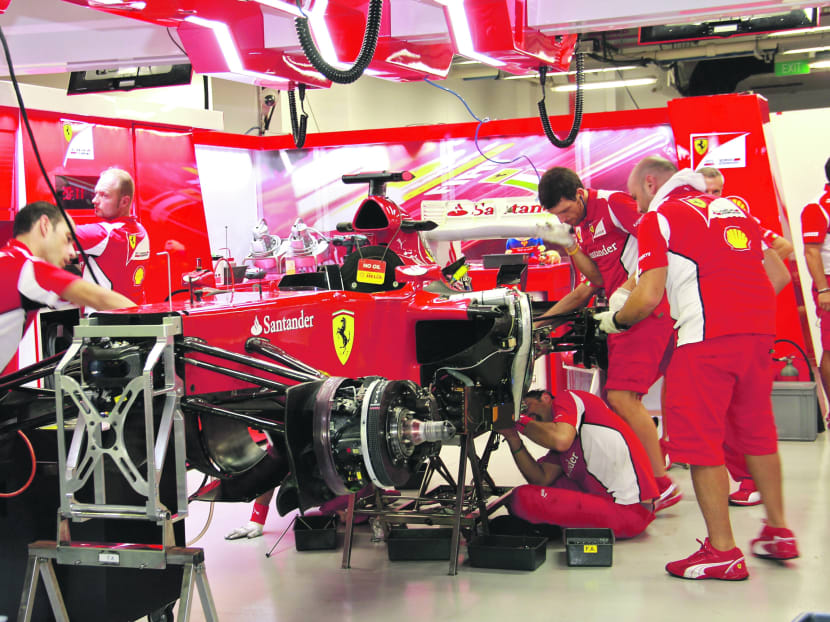Night race must start reeling in investments
When Rolls-Royce regional director Jonathan Asherson was asked earlier this week why the aircraft engine maker was shifting its manufacturing focus to its S$550 million Singapore plant when there is no aircraft industry here, he said it was about talent.

Ferrari engineers working on the car during last year’s Singapore Grand Prix. Top engineers from the F1 teams will drop by tertiary institutions here to inspire budding minds with insights on how they build the fastest racing machines on earth. TODAY file photo
When Rolls-Royce regional director Jonathan Asherson was asked earlier this week why the aircraft engine maker was shifting its manufacturing focus to its S$550 million Singapore plant when there is no aircraft industry here, he said it was about talent.
The focus of education and training in Asia, he added, are in areas of technology and engineering, and the talent pipeline that the aircraft industry and company need “remain solid”.
Rolls-Royce produces technology at the highest levels and its Singapore base is assembling engines for the Airbus 380. Its focus on Singapore is an endorsement of the talent coming out from this part of the world.
Brains that produce equally cutting-edge technology will be hitting town this week, for the sixth SingTel Singapore Grand Prix that starts on Friday. As in previous years, top engineers from the Formula 1 racing teams will drop by tertiary institutions to inspire budding minds with insights on how they build the fastest racing machines on earth.
Engineers of world champions Red Bull such as the legendary Adrian Newey have previously popped by the National University of Singapore, where students have been designing and building race cars since 2001 for overseas competitions.
This evening, Red Bull driver Mark Webber will be at the NUS Engineering Design & Innovation Centre to launch the Infiniti Performance Engineering Academy, which will be based in the United Kingdom. The Red Bull programme aims to pick two aspiring F1 engineers from around the world to work at their Milton Keynes base in the UK next year and learn their automotive craft.
Earlier in the day, Newey’s counterparts from McLaren and Sauber, and tyre makers Pirelli will share their stories with Nanyang Technological University undergraduates, especially on how their innovations have benefited industries outside of motor sports.
The priority of organisers in the first five years of Formula 1’s only night race was to build the event into a global attraction to meet the economic objectives of the country.
A study commissioned by the Government revealed at last year’s race stated that from 2008 to 2017, when Singapore’s second five-year race deal expires, the country would have netted S$2 billion in economic benefits.
Half of that will come from direct tourist spending and the rest from knock-on effects, chiefly in visitor arrivals and investments to the Republic following the global media coverage of the races.
An important partner in achieving this goal is Singaporeans, both businesses and citizens.
Earlier this year, the Singapore Tourism Board told TODAY that more than half of the work to run the race each year are sub-contracted to local small and medium enterprises (SMEs). These include stage production companies, support crew, and businesses involved in track infrastructure and operating hospitality services. According to organisers Singapore GP, to run a successful night race, about 20,000 people are employed each year.
They have also stepped up a gear this year to win over more Singaporeans, by organising paddock tours for schools and companies. There will also be the first-ever pit lane walk before race proceedings tomorrow for about 2,500 non-ticketholders to view the F1 garages up close, and enjoy live performances and interactive games there.
But if Singapore is to take full advantage of running Formula 1 on its streets, a concerted effort must be made by government agencies and private businesses in the next five years to realise the investment goals that last year’s study has anticipated.
So far only McLaren’s sister company, McLaren Automotive, has set up shop here. But Formula 1 churns out technology not only for racing, but also for products outside of motor sports, such as everyday cars, information technology and even for items like fishing lines.
The value of motor sports and related industries like research and development that create 40,000 jobs was worth £6 billion (S$12 billion) last year in the UK, according to the Motorsport Industry Association.
Singapore’s challenge now is to do a Rolls-Royce with F1: To raise a motor sports industry, even if there are no plants building cars here.
The writer is senior F1 correspondent at TODAY





